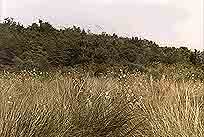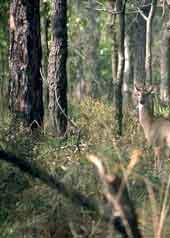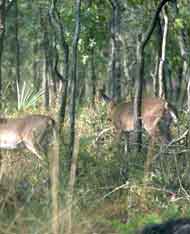|
|
|||||||||||||||||
|
|||||||||||||||||
|
of Central Florida by Jim and Cynthia Tunstall |
|||||||||||||||||
| Typical
residents you'll be likely to encounter on a Central Florida trek. |
|||||||||||||||||
 Christmas ChristmasTosohatchee State Reserve, (407-568-5893), on Hwy 50, 22 miles east of Orlando near the town of Christmas, offers three- , four- and 6-mile hiking trails that can be combined for a 13-mile march. Note that you may be sharing the trail with horseback riders. Also note that if you’re a real marathon sort you can use these to make a round-trip march of 27 miles. The 28,000-acre site cuddles the St. Johns River, near the end of the longest trail. It’s a mosaic of swamp, marsh, pine flatwoods and hammocks. You’re likely to encounter eagles, hawks, otters, white-tail deer, wild turkeys and wild pigs. Keep your distance from the latter – especially the males, who often lack a sense of humor and can run a lot faster than most of you. In fact, give a wide berth to anything wild, including turkeys; they also have attitude problems. This, too, is part of the Florida Trail which, when finished, will reach 1,300 miles across Florida. Just in case you’re a tad curious – even if you’re not – the park’s name, already hard to pronounce, is shortened from "Tootoosahatchee," which in a native American dialect means "chicken creek." As far as the locals can tell, the chickens are long gone. Apopka Rock Springs Run State Reserve, (407-884-2009), near Apopka, features 23 miles of hiking trails, some of which border its namesake spring, hammocks, pine flatwoods and swamps. The reserve is an 8,750-acre tract that’s inhabited by several rare species, including sandhill cranes, scrub jays, woodstorks and Florida black bears. Nearby Wekiva Springs State Park, (407-884-2009) has 13 miles of hiking paths, all maintained by the Florida Trail Association. Its namesake spring discharges 42 million gallons of water per day. Some of the trails also border part of Rock Springs Run. The 6,900-acre park is a habitat for many species, including alligators, river otters, white ibises, bald eagles, ospreys, great barred owls and fox squirrels. Cabbage palms and oak hammocks are common near the water while sandhills and scrub decorate the uplands. The park also has a national champion sand pine and a number of mounds left over from the days of the peace-loving Timucuan Indians. The St. Johns River Water Management District, (904-329-4404), has set up hiking trails on several of its public tracts: The Lake Jessup Conservation Area has six miles of nature trails along the same-named lake. The area is primarily wet prairie grasslands leading back to thick hammocks. Birds rule here, including white ibises, red-shoulder and red-tail hawks, great blue herons, bald eagles and ospreys. The Little-Big Econ State Forest offers a 13-mile leg of the Florida Trail that follows Hwys 419 and 420 and a five-mile trail loop. This is another nice spot for viewing an assortment of rare and migratory birds such as woodstorks, roseate spoonbills, sandhill cranes and eagles. Click here forAbsolutely Florida's story about the Econlockhatchee River. The Seminole Ranch Conservation Area provides a whopping 35 miles of pathways, including 4.3 miles of the Florida Trail, flanking the St. Johns River, several lakes and wilderness areas. Since the area has one-third the salinity of seawater, it provides a nifty bedroom for marine organisms and many of the birds that you’ve recently encountered. The Wekiva Buffers Conservation Area has a seven-mile roundtrip hike through wetlands bordering the river. This is a good place to see river otters, the usual assortment of birdlife (including barred owls) and an occasional black bear. The Hal Scott Regional Preserve & Park has a 15-mile hiking trail that’s shared with the horse crowd. This is an area mainly of upland pines and prairie, populated by bobcats, indigo snakes, gopher tortoises and others. To get a handy little guide with more information and directions on these tracts, write to the St. Johns River Management District at P.O. Box 1429, Palatka, FL 32178-1429. Additionally, the Florida Trail has three long legs in this region, portions of which are included in the areas already listed. They are: Cassia, 36 miles long, offers a look at "The Senator," believed to be the biggest (138 feet high and 17 feet in diameter) and oldest (3,500 years old) cypress tree in the world. Lake Jessup, 29 miles long, skirts Orlando’s more developed areas. Tosohatchee, 32.8 miles, wanders through swamps and uplands along the St. Johns River and passes 30 Indian mounds. Seminole State Forest |
|||||||||||||||||
 |
|||||||||||||||||
|
|
|||||||||||||||||
|
Florida
Recreation For directions, call Florida
Trail Association |
|||||||||||||||||
 |
|||||||||||||||||
|
|
|||||||||||||||||
|
|
|||||||||||||||||


